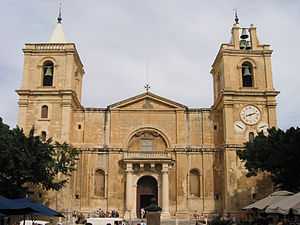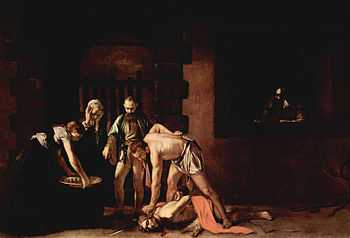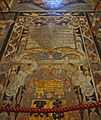St. John's Co-Cathedral
| St John's Co-Cathedral | |
|---|---|
 | |
| Basic information | |
| Geographic coordinates | 35°53′52″N 14°30′46″E / 35.89778°N 14.51278°ECoordinates: 35°53′52″N 14°30′46″E / 35.89778°N 14.51278°E |
| Affiliation | Roman Catholic |
| Ecclesiastical or organizational status | Cathedral |
| Leadership | Archdiocese of Malta |
| Website | www.stjohnscocathedral.com |
| Architectural description | |
| Architect(s) | Glormu Cassar |
| Architectural type | Church |
| General contractor | Jean de la Cassière |
| Direction of façade | SW |
| Groundbreaking | 1572 |
| Completed | 1577 |
| Specifications | |
| Length | 65 metres (213 ft) |
| Width | 40 metres (130 ft) |
| Width (nave) | 20 metres (66 ft) |
St. Johns Co-Cathedral (Maltese: Kon-Katidral ta’ San Ġwann), located in Valletta, Malta, was built by the Knights of Malta between 1573 and 1578, having been commissioned in 1572 by Grand Master Jean de la Cassière as the conventual church of the Order of the Knights Hospitaller of St John, known as the Knights of Malta. The Church was designed by the Maltese military architect Glormu Cassar (Girolamo Cassar) who designed several of the more prominent buildings in Valletta. The church is considered to be one of the finest examples of high Baroque architecture in Europe and one of the world's great cathedrals.
Facade
The severe exterior of the Cathedral, built immediately after the ending of the Great Siege of 1565, is reminiscent of a military fort.
Interior

The interior, in sharp contrast with the facade, is extremely ornate [1] and decorated in the height of the Baroque period. The interior was largely decorated by Mattia Preti, the Calabrian artist and Knight. Preti designed the intricate carved stone walls and painted the vaulted ceiling and side altars with scenes from the life of St John. Interestingly, the figures painted into the ceiling next to each column initially appear to the viewer as three-dimensional statues, but on closer inspection we see that the artist cleverly created an illusion of three-dimensionality by his use of shadows and placement. Also noteworthy is the fact that the carving was all undertaken in-place (in-situ) rather than being carved independently and then attached to the walls (stucco). The Maltese limestone from which the Cathedral is built lends itself particularly well to such intricate carving. The whole marble floor is an entire series of tombs, housing about 375 Knights and officers of the order. There is also a crypt containing the tombs of Grandmasters like Philippe Villiers de L'Isle-Adam, Claude de la Sengle, Jean Parisot de Valette, and Alof de Wignacourt.
In 1666, a project for the main altar by Malta's greatest sculptor, Melchiorre Cafà, was approved and begun. Cafà intended a large sculpture group in bronze depicting the Baptism of Christ. Following Cafà's tragical death in 1667 in a foundry accident while working on this work in Rome, the plans were abandoned. Only in 1703, Giuseppe Mazzuoli, Cafà's only pupil, finished a marble group of the Baptism of Christ which might have been influenced by his master's undocumented designs but certainly is strongly dependent on a small baptism group by Alessandro Algardi.[2]
Near the main entrance one finds the monument of Grand Master Fra Marc'Antonio Zondadari of Siena. He was the nephew of Pope Alexander VII.
Chapels

The Cathedral contains eight rich chapels, each of which was dedicated to the patron saint of the 8 langues (or sections) of the Knights. On the left side of the church there are the following chapels;
The Chapel of the Anglo-Bavarian Langue was formerly known as the Chapel of the Relic where the Knights used to keep relics that they have acquired through the centuries.
The Chapel of Provence is dedicated to Saint Michael.
The Chapel of France is dedicated to the Conversion of Saint Paul. This chapel was modified in the 19th century. The monuments found in this chapel are those of grandmasters Fra Adrien de Wignacourt and Fra Emmanuel de Rohan-Polduc.
The Chapel of Italy, dedicated to St Catherine, the patron saint of the Italian section.
The Chapel of Germany is dedicated to the Epiphany of Christ. The titular paint is by Stefano Erardi, a Maltese painter.
On the right side of the church there are the following chapels;
The Chapel of Blessed Sacrament was formerly known as the Chapel of Our Lady of Fileremos (Rhodes). The titular painting of this chapel is Our Lady of Carafa which is a copy of Our Lady of Lanciano. Among the knight buried in this chapel there is Fra Gian Francesco Abela and Fra Flaminio Balbiano.
The Chapel of Auvergne is dedicated to Saint Sebastian. The only monument in this chapel is that of Fra Annet de Clermont.
The Chapel of Aragon is dedicated to St. George. The titular painting was painted by Mattia Preti and it is considered as one of his masterpieces. In this chapel one can find the monuments of the following grandmasters, Fra Martin de Redin, Fra Raphael Cotoner, Fra Nicolas Cotoner, Fra Ramon Perellos.
The Chapel of Castile, Leon, and Portugal dedicated to James the Greater. The monuments in this chapel are those of grandmasters Fra Antonio Manoel de Vilhena and Fra Manuel Pinto da Fonseca.
Other works of art

The painting depicting The Beheading of Saint John the Baptist (1608) by Caravaggio (1571–1610) is the most famous work in the church. Considered one of Caravaggio's masterpieces and the only painting signed by the painter, the canvas is displayed in the Oratory for which it was painted. Restored in the late 1990s in Florence, this painting is one of Caravaggio's most impressive uses of the chiaroscuro style for which he is most famous with a circle of light illuminating the scene of St John's beheading at the request of Salome. The oratory also houses Caravaggio's St Jerome III (1607–1608).
Another impressive feature of the church is the collection of marble tombstones in the nave in which were buried important knights. The more important knights were placed closer to the front of the church. These tombstones, richly decorated with in-laid marble and with the coats of arms of the knight buried below as well as images relevant to that knight, often telling a story of triumph in battle, form a rich visual display in the church.
Adjoining to the church is the St John's Co-Cathedral Museum containing art objects. Among the contents of the museum there are the Tapestries of Grandmaster Fra Ramon Perellos de Roccaful, paintings of the following Grandmasters Fra Jean de la Cassiere, Fra Nicola Cottoner and Fra Emanuel Pinto de Fonseca, painting which were formerly in the side chapel such as St. George killing the Dragon by Francesco Potenzano.
Visiting
The cathedral is open to visitors from
Monday to Friday: 09.30 to 16.30 (last admission at 16.00) Saturdays: 09.30 to 12.30 (last admission at 12.00). Closed on Sunday and Public Holidays. The entrance fee includes the provision of audio guides with 24 stops. These guides are available to visitors in six languages (Maltese, English, Italian, French, German and Spanish).
Other information
St. John's was the conventual church (that is to say, the church of the convent) of the Hospitallers (the Knights of Saint John). Over time, though, it grew to equal prominence with the archbishop's cathedral at Mdina. In the 1820s, the Bishop of Malta, whose seat was at Mdina, was allowed to use St John’s as an alternative see and it thus formally became a Co-Cathedral. The land on which the Co-cathedral was built belongs to the Government of Malta and the care of the Co-Cathedral and museum has been entrusted to the St John's Co-Cathedral Foundation whose executive secretary is Dr Claude P.P. Busuttil. The curator is Ms Cynthia de Giorgio, while the project's Coordinator is Mr Dane Munro.
References
Bibliography
- Sante Guido, Giuseppe Mantella, "Mattia Preti e la volta della Chiesa Conventuale di San Giovanni Battista a La Valletta: documenti e testimonianze 1661-2011 per il 350° anniversario dell'inizio lavori" in I BENI CULTURALI, v. XIX - 3, n. 3 maggio-giugno 2011 (2011), p. 7-28.
- Sante Guido, Giuseppe Mantella, STORIE DI RESTAURI NELLA CHIESA CONVENTUALE DI SAN GIOVANNI A LA VALLETTA. La cappella di santa Caterina della Lingua d'Italia e le committenze del gran maestro Gregorio Carafa, Malta, MidseaBooks, 2008, 494 p. - ISBN 978-99932-7-202-1.
- Sante Guido, Giuseppe Mantella, "Restauri e riscoperte di scultura del barocco romana a Malta. Capolavori per l'Ordine dei cavalieri di san Giovanni.", Malta, Midsea Books LTD, 2005, 144 p. - ISBN 99932-7-046-6.
- Sante Guido, Giuseppe Mantella, "Il restauro del Reliquiario del Braccio di San Giovanni Battista nella Co-Cattedrale di La Valletta" in BOLLETTINO ICR, n.s., v. 2003 - 6-7, n. 6-7 gennaio-dicembre 2003 (2003), p. 33-49.
Interior Gallery
See also
See also
External links
| Wikimedia Commons has media related to St John's Co-Cathedral. |
- Official website of St John's Co-Cathedral
- Photosynth of the Main Altar of St. John's Co-Cathedral
- Photosynth of the Facade of St. John's Co-Cathedral
- maltain360.com - 360° view of St John's Co-Cathedral
The bells of St. John's Co Cathedral at Valletta:
- PLENUM
- The 2 Bells Ringing Instant a Peal Those 2 bells is 3rd bell (SI2) and big bell (SOL2) of this cathedral. The mass of big bell is 7000 kg and is 3rd great bell of Malta.





